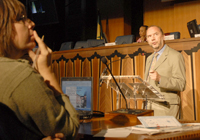
Dr Piot traced the history of the AIDS epidemic in Africa over the past quarter century and highlighted some key milestones in the response during a plenary session at ICASA on Thursday. Credit: UNAIDS/Mamadou Gomis
“We can not predict the future but we can certainly influence it,” said UNAIDS Executive Director Dr Piot looking ahead after his review of the past 25 years of AIDS in Africa. Dr Piot traced the history of the AIDS epidemic in Africa over the past quarter century and highlighted some key milestones in the response during a plenary session at ICASA on Thursday.
His presentation illustrated the history of AIDS from the explosive growth of the first AIDS cases in central Africa to an epidemic of well over 20 million people across the continent, and Africa’s main cause of death.
During his speech, Dr Piot underlined how emerging political leadership and civil society activism have helped to remove the silence and denial that surrounded the epidemic in the 1980s and early 90s. In some African countries, this has helped mobilize high level political commitment that is now producing results such as fewer people becoming newly infected with HIV and fewer people dying.
Dr Piot also recalled some key meetings and events, such as the Abuja Declaration on HIV in 2001; the creation of the Drug Access Initiative, and the launch of Africa’s first national AIDS treatment programme (in Botswana). He also covered some of the continent’s impressive scientific contributions to the global AIDS effort. Among these are the discoveries of HIV-2 and SIV, genetic heterogeneity of HIV, mechanisms and prevention of heterosexual and perinatal transmission, the use of cotrimoxazole to treat and prevent opportunistic infections, male circumcision.

Members of the audience for Dr Piot’s presentation Credit: UNAIDS/Mamadou Gomis
As well as reviewing progress so far, the presentation looked at some of the many challenges that lie ahead. These include sustaining political commitment and funding, expanding coverage of access to antiretroviral treatment, intensifying HIV prevention, increasing technical and community capacity, and connecting the AIDS response with other public health and development efforts. Above all, Dr Piot underscored the need to know the local modes of HIV transmission in order to better tailor prevention measures/programmes.
Last week UNAIDS launched a new report calling on countries to realign HIV prevention programmes through understanding how the most recent HIV infections were transmitted, and understanding the reasons why they occurred.
“Not only will this approach help prevent the next 1,000 infections in each community, but it will also make money for AIDS work more effectively and help put forward a long term and sustainable AIDS response,” said UNAIDS Executive Director Dr Peter Piot.
Finally, Dr Piot emphasized the need to maintain an exceptional response to AIDS, not only as a short term emergency but as a long-term event that requires broad partnerships, leadership and commitment. “We can not predict the future but we can certainly influence it,” said Dr Piot.





